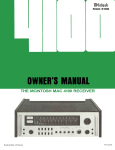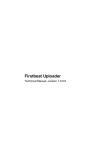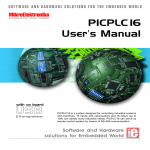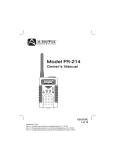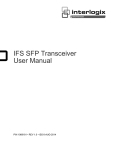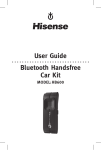Download Radio Shack 19-902 Owner`s manual
Transcript
19-902.fm Page 1 Tuesday, August 3, 1999 2:03 PM Cat. No. 19-902 OWNER’S MANUAL Please read before using this equipment. PRS-102 UHF 10-Channel Personal Radio Service Transceiver 19-902.fm Page 2 Tuesday, August 3, 1999 2:03 PM CAUTION RISK OF ELECTRIC SHOCK. DO NOT OPEN. ! CAUTION: TO REDUCE THE RISK OF ELECTRIC SHOCK, DO NOT REMOVE COVER OR BACK. NO USER-SERVICEABLE PARTS INSIDE. REFER SERVICING TO QUALIFIED PERSONNEL. This symbol is intended to alert you to the presence of uninsulated dangerous voltage within the product’s enclosure that might be of sufficient magnitude to constitute a risk of electric shock. Do not open the product’s case. ! This symbol is intended to inform you that important operating and maintenance instructions are included in the literature accompanying this product. 1996 Tandy Corporation. All Rights Reserved. RadioShack is a trademark used by Tandy Corporation. 2 19-902.fm Page 3 Tuesday, August 3, 1999 2:03 PM FEATURES Your RadioShack PRS-102 10-Channel Personal Radio Service Transceiver is a portable, two-way GMRS (General Mobile Radio Service) transceiver that you can carry almost anywhere. The transceiver is compact and light, making it an ideal choice for your personal needs. Your transceiver has the following features: Ten Frequencies — you can set the transceiver to operate on any of these frequencies: Channel 1 2 3 4 5 6 7 8 9 10 Frequency 462.5625 MHz 462.5875 MHz 462.6125 MHz 462.6375 MHz 462.6625 MHz 462.6875 MHz 462.7125 MHz 462.5750 MHz 462.6250 MHz 462.6750 MHz Note: Operation on GMRS frequencies requires a Federal Communications Commission (FCC) license. PLL (Phase-Locked Loop)-Controlled Circuitry — provides accurate and stable channel selection. Built-In Modulation Limiter Circuit — automatically adjusts for a wide variety of voice levels to ensure an understandable transmission. 3 19-902.fm Page 4 Tuesday, August 3, 1999 2:03 PM Rugged Design — built to stand up to daily use in a wide range of environments. Battery Low and Transmit Indicator — shows the battery pack’s condition and lights when you transmit. Supplied Battery Charger — conveniently recharges your transceiver’s supplied battery pack up to several hundred times for reduced operating costs. Earphone Jack and External Microphone Jack — let you use an earphone or external microphone to help ensure understandable communications in noisy areas. CTCSS (Continuous Tone Coded Squelch System) Option (not supplied) — helps reduce interference from other nearby systems operating on the same frequency. We recommend you record your transceiver’s serial number here. The number is on the back of the transceiver. Serial Number ____________________________ 4 19-902.fm Page 5 Tuesday, August 3, 1999 2:03 PM CONTENTS FCC Regulations . . . . . . . . . . . . . . . . . . . . . . . . . 6 FCC License Required . . . . . . . . . . . . . . . . . . 6 FCC Rules Part 95, Subpart A . . . . . . . . . . . . 7 Preparation . . . . . . . . . . . . . . . . . . . . . . . . . . . . . Installing and Removing the Battery Pack . . Installing the Antenna . . . . . . . . . . . . . . . . . . Charging the Battery Pack . . . . . . . . . . . . . . Checking the Battery Power . . . . . . . . . Attaching and Removing the Belt Clip . . . . . Connecting Audio Accessories . . . . . . . . . . . 10 10 11 12 14 15 16 Operation . . . . . . . . . . . . . . . . . . . . . . . . . . . . . . 17 Operational Hints . . . . . . . . . . . . . . . . . . . . . 18 CTCSS Option . . . . . . . . . . . . . . . . . . . . . . . . . . 19 Why Use CTCSS? . . . . . . . . . . . . . . . . . . . . 19 Setting the CTCSS Tone . . . . . . . . . . . . . . . 20 Optional Accessories . . . . . . . . . . . . . . . . . . . . . 24 Troubleshooting . . . . . . . . . . . . . . . . . . . . . . . . . 25 Maintenance . . . . . . . . . . . . . . . . . . . . . . . . . . . . 29 Specifications . . . . . . . . . . . . . . . . . . . . . . . . . . 31 5 19-902.fm Page 6 Tuesday, August 3, 1999 2:03 PM FCC REGULATIONS FCC LICENSE REQUIRED Before you operate the transceiver, you must obtain your license. It is illegal to transmit without the appropriate license, which you can get by submitting a completed Federal Communications Commission (FCC) Form 574. You can get the latest FCC forms and instructions from several sources: • To have the forms faxed to you by the FCC, call the FCC Fax-On-Demand system at 202-4180177 from your fax machine and request Document 000574 for all forms and instructions, or Document 005741 for instructions only. • To have the forms mailed to you, call the FCC Forms Hotline at 800-418-FORM. For questions concerning the license application, contact the FCC at 717-337-1212 or 1-800-322-1117. 6 19-902.fm Page 7 Tuesday, August 3, 1999 2:03 PM FCC RULES PART 95, SUBPART A You must be familiar with Part 95, Subpart A of FCC Rules and Regulations before you operate your transceiver. The operation instructions in this manual conform to Part 95, but do not cover all items in Part 95. In part, Part 95, Subpart A, states that: • You must be 18 years of age, or older, and not a representative of a foreign government to get a license. • Businesses or associations cannot qualify for a GMRS license. • A licensee can let immediate family members operate under GMRS Rules and Regulations. • Channels or channel pairs assigned to GMRS systems are available on a shared basis and will not be assigned for the exclusive use of any licensee. • As licensee, you are responsible for proper operation of all transceivers operating under your license. • You must take reasonable precautions to prevent harmful interference to others operating on the same frequency. 7 19-902.fm Page 8 Tuesday, August 3, 1999 2:03 PM • You must not transmit program material of any kind used in connection with commercial broadcasting. • You must not provide a service that is normally handled by telephone or telegraph unless such broadcasts involve the safety of life or property or in emergencies such as an earthquake, hurricane, flood, or a similar disaster where normal communication channels are disrupted. Violating any of the provisions of Part 95 can result in fines and/or confiscation of equipment. The General Mobile Radio Service is under the jurisdiction of the Federal Communications Commission (FCC). Any adjustments or alterations that would alter the performance of the transceiver so it no longer meets the original FCC type acceptance or would change the frequency-determining method are strictly prohibited. Replacement or substitution of crystals, transistors, ICs, regulator diodes, or any other component that is of a unique nature, with components other than those recommended, can violate the technical regulations of FCC Rules and Regulations or violate type acceptance requirements of the rules. 8 19-902.fm Page 9 Tuesday, August 3, 1999 2:03 PM Your transceiver might cause TV or radio interference even when it is operating properly. To determine whether your transceiver is causing the interference, turn off your transceiver. If the interference goes away, your transceiver is causing it. Try to eliminate the interference by: • Moving your transceiver away from the TV or radio • Contacting your local RadioShack store for help If you cannot eliminate the interference, the FCC requires that you stop using your transceiver. 9 19-902.fm Page 10 Tuesday, August 3, 1999 2:03 PM PREPARATION Before you use the transceiver, you must be properly licensed by the FCC. If you already have a GMRS license, you can immediately use the transceiver. INSTALLING AND REMOVING THE BATTERY PACK Caution: Do not remove the plastic wrap from the battery pack. Doing so can permanently damage the battery. 1. Be sure the transceiver is turned off. 2. Unlock the battery compartment cover latch on each side. (The orange tabs should be visible.) Then slide the cover down and lift it off. Battery Compartment Cover Cover Latch 10 19-902.fm Page 11 Tuesday, August 3, 1999 2:03 PM 3. With the battery label facing up, align the battery pack and radio’s battery contacts. Apply slight pressure to the bottom of the battery pack and press it into the compartment, as shown. 4. Slide the battery cover back into place and lock it with the latches. To remove the battery pack, unlock the compartment and remove the cover. Then turn the transceiver face down and gently tap the battery pack into your palm. INSTALLING THE ANTENNA To install the antenna, place the threaded end of the antenna over the antenna connector on top of the tranceiver and screw it into place. 11 19-902.fm Page 12 Tuesday, August 3, 1999 2:03 PM CHARGING THE BATTERY PACK You must charge the battery pack with the supplied battery charger or with an optional charger (see “Optional Accessories” on Page 24) before you use the tranciever for the first time and whenever the battery becomes low. Follow these steps to charge the battery pack using the supplied charger. 1. If the transceiver is on, turn VOL•OFF counterclockwise to turn it off. 2. Lift the protective cover away from the accessory jacks. 3. Plug the charger into the small (lower) jack, then connect the charger to a standard AC outlet. The charger’s charge indicator lights. Charger Charge Indicator Note: Charging takes about 10 hours. 12 19-902.fm Page 13 Tuesday, August 3, 1999 2:03 PM Cautions: • Do not operate the transceiver while you charge the battery pack. Using the battery charger mutes the transceiver’s speaker. • To ensure a full charge, do not charge the battery pack in an area where the temperature is above 95°F. To prevent permanent battery power loss, do not charge the battery at temperatures below 43°F. • Use only the supplied or recommended chargers to recharge the transceiver’s battery pack. Using any other charger could permanently damage your transceiver or the battery pack. • A fully charged battery will last about 8 hours in the PRS-102. Important: This transceiver uses a rechargeable nickel-cadmium battery pack. At the end of the battery pack’s useful life, it must be recycled or disposed of properly. Contact your local, county, or state hazardous waste management authorities for information on recycling or disposal programs in your area. Some options that might be available are: municipal curbside collection, drop-off boxes at retailers, recycling collection centers, and mail-back programs. 13 19-902.fm Page 14 Tuesday, August 3, 1999 2:03 PM Checking the Battery Power 1. Rotate VOL•OFF clockwise to turn on the transceiver. 6 0 1 7891 2. Press the push-to-talk button on the left side of the transceiver. If the indicator next to the antenna lights red, there is sufficient battery power for transmission. If the indicator does not light, you need to recharge the battery pack. 2345 VOL • OFF Battery Low/Transmit Indicator 14 Top View 19-902.fm Page 15 Tuesday, August 3, 1999 2:03 PM ATTACHING AND REMOVING THE BELT CLIP To attach the belt clip, align it with the rails on the back of the transceiver and slide the clip down until it snaps into place. To remove the belt clip, lift the release tab away from the radio. While holding the tab, slide the belt clip up off the mounting rails. Release Tab 15 19-902.fm Page 16 Tuesday, August 3, 1999 2:03 PM CONNECTING AUDIO ACCESSORIES You can order a wide variety of audio accessories for your transceiver from your local RadioShack store. See “Optional Accessories” on Page 24. Follow these steps to connect an audio accessory. Protective Cover Audio Accessory Jacks 1. Turn off the transceiver. 2. Lift the protective cover away from the accessory jacks. 3. If the accessory has two plugs, align the smaller plug with the small jack and the larger plug with the large jack and plug them in. If the accessory has a single plug, plug it into the matching jack. 16 19-902.fm Page 17 Tuesday, August 3, 1999 2:03 PM OPERATION 6 0 1 7891 1. Turn VOL•OFF clockwise to turn on the transceiver, then rotate the channel knob to select the desired channel. 2345 VOL • OFF 2. Press the transceiver’s monitor button, below the push-to-talk button. While you hold the monitor button, adjust the volume to a comfortable level. Push-to-Talk Button Monitor Button 3. To transmit, press and hold the push-to-talk button, then hold your transceiver about 3 inches from your mouth and speak clearly in a normal tone of voice. The indicator next to the antenna lights red when you hold down the push-to-talk button. 4. When you finish speaking, release the push-totalk button to hear a response. 5. To turn off the transceiver, turn VOL•OFF counterclockwise. 17 19-902.fm Page 18 Tuesday, August 3, 1999 2:03 PM OPERATIONAL HINTS Your transceiver’s range varies depending on factors such as position, terrain, and battery condition. Range can best be described as line of sight. The fewer obstructions you have between two tranceivers, the better range you can expect. Buildings absorb transmitted signals and, if they contain metal, might completely block the signals. Trees and heavy cloud formations have a similar effect, though not as severe. If you are near a lake or the ocean, you might get excellent range. To ensure maximum range, operate the transceiver with the battery pack fully charged. As the voltage decreases, the range decreases. 18 19-902.fm Page 19 Tuesday, August 3, 1999 2:03 PM CTCSS OPTION WHY USE CTCSS? CTCSS (Continuous Tone-Coded Squelch System) is available as an optional add-on to your transceiver. When CTCSS is turned on, the transceiver transmits a selected tone with your transmission. This tone is too low for you to hear, but other transceivers can detect it. If CTCSS is turned on and set to the same tone on the receiving transceiver, it only receives transmissions that include the tone. This way, CTCSS can help keep you from hearing other users on the same frequency. For example, if two different groups operate transceivers in the same area on the same frequency but use a different CTCSS tone, they only hear their own broadcasts. Note: CTCSS does not make your conversations private. Other users can still hear your transmissions if they use the same frequency. 19 19-902.fm Page 20 Tuesday, August 3, 1999 2:03 PM SETTING THE CTCSS TONE Notes: • If you are a part of a talk group, be sure all of the radios in the talk group use the same tone. • You must install the CTCSS option before you can set the CTCSS tone. 1. Turn off the radio. 2. Unlock the battery compartment cover latch on each side. (The orange tabs should be visible.) Then slide the cover down and lift it off. Battery Compartment Cover Cover Latch 3. Remove the battery pack and tray. This exposes the bank of CTCSS switches. 20 19-902.fm Page 21 Tuesday, August 3, 1999 2:03 PM 4. Select any one CTCSS code found in the table on Pages 22 and 23, then find the corresponding switch positions in the tables. 5. With a pointed instrument, such as a pin, place the dip switches in the positions that match the desired tone. For example: 1 2 3 4 5 6 7 8 Up Position Down Position Note: Setting Switch 8 to the down position disables the CTCSS feature. You must set the switch to the up position to turn on CTCSS. 6. After setting your CTCSS code, replace the battery tray, battery pack, and battery compartment cover, then turn on the transceiver. 21 19-902.fm Page 22 Tuesday, August 3, 1999 2:03 PM SWITCH POSITION (U=Up, D=Down) CTCSS CODE FREQ (Hz) 1 2 3 4 5 6 7 8 XZ 67.0 D D D D D D U U 22 XA 71.9 U D D D D D U U WA 74.4 D D D D D U U U XB 77.0 U U D D D D U U WB 79.7 D D D D U D U U YZ 82.5 U D D D D U U U YA 85.4 D D D D U U U U YB 88.5 U U D D D U U U ZZ 91.5 D D D U D D U U ZA 94.8 U D D D U D U U ZB 97.4 D D D U D U U U 1Z 100.0 U U D D U D U U 1A 103.5 U D D D U U U U 1B 107.2 U U D D U U U U 2Z 110.9 U D D U D D U U 2A 114.8 U U D U D D U U 2B 118.8 U D D U D U U U 3Z 123.0 U U D U D U U U 3A 127.3 U D D U U D U U 3B 131.8 U U D U U D U U 19-902.fm Page 23 Tuesday, August 3, 1999 2:03 PM SWITCH POSITION (U=Up, D=Down) CTCSS CODE FREQ (Hz) 1 2 3 4 5 6 7 8 4Z 136.5 U D D U U U U U 4A 141.3 U U D U U U U U 4B 146.2 U D U D D D U U 5Z 151.4 U U U D D D U U 5A 156.7 U D U D D U U U 5B 162.2 U U U D D U U U 6Z 167.9 U D U D U D U U 6A 173.8 U U U D U D U U 6B 179.9 U D U D U U U U 7Z 186.2 U U U D U U U U 7A 192.8 U D U U D D U U M1 203.5 U U U U D D U U M2 210.7 U D U U D U U U M3 218.1 U U U U D U U U M4 225.7 U D U U U D U U M5 233.6 U U U U U D U U M6 241.8 U D U U U U U U M7 250.3 U U U U U U U U X X X X X X X D Disable CTCSS Note: X = either Up or Down 23 19-902.fm Page 24 Tuesday, August 3, 1999 2:03 PM OPTIONAL ACCESSORIES RadioShack Cat. No. 19-351 Description Remote Speaker Microphone These items are available by special order from your local RadioShack store: 19-352 19-353 19-354 19-355 19-356 19-357 19-358 19-359 19-360 19-361 19-362 19-363 19-364 19-365 19-367 24 Earpiece w/Microphone External VOX Adapter Earbud Headset w/Swivel Boom Microphone Earbud w/Clip Microphone and PTT Flexible Ear Receiver Leather Carry Case with Belt Loop Nylon Carry Case Spring Action 3-Inch Belt Clip Ni-Cd Battery Pack 120 Volt 3-Hour Desktop Charger 120 Volt 10-Hour Desktop Charger CTCSS Kit BNC Adapter UHF Stubby Antenna 19-902.fm Page 25 Tuesday, August 3, 1999 2:03 PM TROUBLESHOOTING If you have a problem operating your transceiver, first review this manual and be sure that you understand and have followed all instructions. If you still have problems, review the following troubleshooting guide. If the radio still does not work properly after you follow the troubleshooting guide, contact your local RadioShack store for additional assistance. Note: Do not disassemble the radio in any way. The radio contains no user-serviceable components. Symptom Radio does not operate. Possible Problem Solution • Battery pack is dead. • Press and hold the push-to-talk button while looking at the indicator. If the indicator does not light or turns off, charge the battery pack. • Battery pack is not positioned correctly in the transceiver. • Correctly install the battery pack. 25 19-902.fm Page 26 Tuesday, August 3, 1999 2:03 PM Symptom Battery pack does not charge or last long enough. Possible Problem • Battery pack incorrectly charged. Solution • If you use an optional charger, be sure the battery pack is correctly positioned. If you use the supplied battery charger, be sure the charger’s indicator turns on. • Battery pack not • Do not turn on the transceiver while fully charged. charging the battery pack . It takes longer to charge the battery pack if the transceiver is on. • Heavy usage. 26 • Usage beyond the standard duty cycle of 5% transmitting, 5% receiving, and 90% idle might require a spare battery pack or recharging during the day. 19-902.fm Page 27 Tuesday, August 3, 1999 2:03 PM Symptom Other users do not hear your transmissions or you do not hear other transmissions. Possible Problem Solution • Transceivers are on different frequencies. • Have all transceivers set to the same frequency. • CTCSS settings are different. • If you use the CTCSS option, verify that other transceivers are set to the same CTCSS code (see “CTCSS Option”). • CTCSS must be dis• Transceivers abled to hear transwith and withceivers not using out the CTCSS CTCSS (see option are being “CTCSS Option”). used. You hear • Other users are other conlicensed to use versations or the same frenoise. quency in your area. • You might have a CTCSS board installed that is not activated. • Users do not have exclusive use of frequencies. Adding CTCSS screens out other users’ conversations on your transceiver, but your conversations are still heard by others sharing your frequency (see “CTCSS Option”). • Check CTCSS Switch 8 to verify that it is in the UP position (see “CTCSS Option”). 27 19-902.fm Page 28 Tuesday, August 3, 1999 2:03 PM Symptom Limited talk range. You hear constant static. 28 Possible Problem Solution • You are using the transceiver in a basement, steel structure, concrete building, vehicle, or heavy foliage. • Move to a different location. For the best range, always use the supplied longer antenna. An optional stubby antenna reduces talk range by 50%. • The radio is located low or very close to your body, as in a pocket or on a belt. • The higher you hold the radio, and the further away from your body, the better the range. • Battery pack power is low. • Charge the battery pack. • The battery pack is not fully charged. • Press and hold the push-to-talk button while looking at the indicator on top of transceiver. If the indicator does not light or turns off, charge the battery pack . • You are using the transceiver near computers or electronic equipment. • You can add the CTCSS option to screen out this type of interference. 19-902.fm Page 29 Tuesday, August 3, 1999 2:03 PM MAINTENANCE Your RadioShack PRS-102 UHF 10-Channel Personal Radio Service Transceiver is an example of superior design and craftsmanship. The following suggestions will help you care for the transceiver so you can use it for years. Keep the transceiver dry. If it gets wet, immediately wipe it dry. Some liquids contain minerals that can corrode the electronic circuits. Use and store the transceiver only in normal temperature environments. Temperature extremes can shorten the life of electronic devices, damage batteries, and distort or melt plastic parts. Handle the transceiver gently and carefully. Dropping it can damage the circuit boards and can cause the transceiver to work improperly. Keep the transceiver away from dust and dirt, which can cause premature wear of parts. 29 19-902.fm Page 30 Tuesday, August 3, 1999 2:03 PM CLEANER Wipe the transceiver with a damp cloth occasionally to keep it looking new. Do not use harsh chemicals, cleaning solvents, or strong detergents to clean the transceiver. Use of chemicals or detergents could damage the plastic case, and leak into the transceiver. Modifying or tampering with the transceiver’s internal components (unless otherwise stated in this manual) can cause a malfunction and might invalidate its warranty and void your FCC authorization to operate it. If your transceiver is not performing as it should, take it to your local RadioShack store for assistance. 30 19-902.fm Page 31 Tuesday, August 3, 1999 2:03 PM SPECIFICATIONS General Channels ............................................................. 10 Size ........................................ 67/8 × 29/16 × 13/8 Inches Weight (with battery pack) .................... 11.5 ounces Power ............ Nickel Cadmium Battery Pack (7.5V) Average Battery Life .................................... 8 Hours Transmitter RF Power Output ......................................... 2 Watts Spurious/Harmonic Emissions ................... 50 µVolts Frequency Stability .................................. ±0.0005% Maximum Frequency Separation ................... 8 MHz Audio Distortion ................................................ <5% FM Noise ...................................................... –40 dB TIA/EIA Audio Response .......................... +1, –3 dB Receiver Channel Spacing .......................................... 25 kHz Sensitivity (12 dB SINAD) ....................... 0.25 µVolts Selectivity ...................................................... –50 dB Intermodulation ............................................. –50 dB Spurious & Image Rejection ......................... –50 dB Frequency Stability (–22 to 140°F) .......... ±0.0005% Maximum Frequency Separation ................... 8 MHz Audio Output (@ 1 kHz, 60% Dev.) EIA (@ <5% Dist.) ............................... 250 mW Specifications are typical; individual units might vary. Specifications are subject to change and improvement without notice. 31 19-902.fm Page 32 Tuesday, August 3, 1999 2:03 PM RadioShack Limited Warranty This product is warranted against defects for 1 year from date of purchase from RadioShack company-owned stores and authorized RadioShack franchisees and dealers. Within this period, we will repair it without charge for parts and labor. Simply bring your RadioShack sales slip as proof of purchase date to any RadioShack store. Warranty does not cover transportation costs. Nor does it cover a product subjected to misuse or accidental damage. EXCEPT AS PROVIDED HEREIN, RadioShack MAKES NO EXPRESS WARRANTIES AND ANY IMPLIED WARRANTIES ARE LIMITED IN DURATION TO THE DURATION OF THE WRITTEN LIMITED WARRANTIES CONTAINED HEREIN. Some states do not permit limitation or exclusion of implied warranties; therefore, the aforesaid limitation(s) or exclusion(s) may not apply to the purchaser. This warranty gives you specific legal rights and you may also other rights which vary from state to state. We Service What We Sell 10/95 RadioShack A Division of Tandy Corporation Fort Worth, Texas 76102 5/96 6880904Z78-O Printed in the USA

































